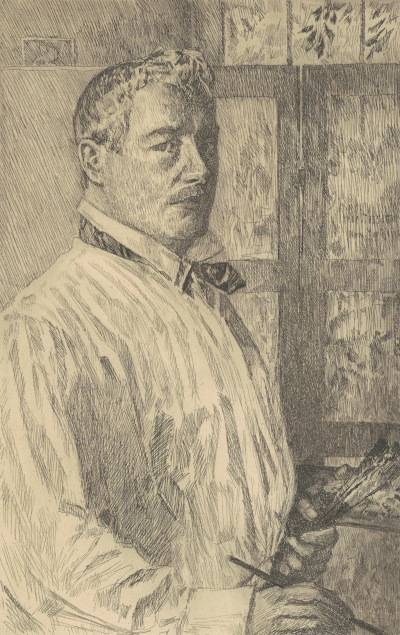Childe Hassam showed promise as a draughtsman before he had even started to work with watercolours or oils. His apprenticeship helped to develop his early skillset, before he then moved on to other mediums.
The artist attended The Mather School and this would be his very first introduction to art. His father had a small collection of paintings which he may well have studied from an early age but there was not a history of art within the family. The young man chose to accept an apprenticeship with an engraving company and impressed with illustrations for various publications. It was clear, even in his late teens, that there was some potential there and whilst completing his apprenticship the artist would study other art forms as his interest started to grow. Soon enough he chose to work for himself and set up as a freelance illustrator. He would then spend several months living in Europe and it was from this point that painting took over as his main focus. That said, he continued to sketch throughout his lifetime and would often prepare study pieces in pencil or charcoal prior to starting the main painting. This helped him to try out different ideas around the composition and avoid amending key elements later on.
The item displayed on this page was actually a Self-Portrait etching from 1916 and can now be found at the National Gallery of Art in the US. The mediums of drawing and etching would have many similarities and in later life Hassam would use the latter to produce series of cheaper reproductions which could be sold to the mainstream art public. He was aware that his original paintings were too expensive for many, but limited edition prints could attract others and also spread his reputation further as a result. His knowledge of etching also led back to his early apprenticeship and much of his career made use of those basic lessons. For many years his drawings were not recorded with great interest but as his career rose in popularity, even his preparatory work would start to achieve some level of value. One today can find several of them within major collections and they help us to see the raw talents of the artist.
The artist would take on a great variety of genres across his career and constantly challenged himself, even though he continued with an Impressionist approach for most of his career. This variety is reflected in his sketches as well, many of which would be put together within artist pads, with the best then being removed and sold separately. At other times he would use them as studies to sit alongside his canvas as he painted the oil or watercolour version. Portraits were regularly sketched, and for his landscape or cityscape scenes he would lay out a composition on paper first with some simple lines of pencil. His cityscapes might include complex architecture and so it was essential to plan the angles in depth before commencing any painting, with later changes being far harder to achieve once oils become involved. In the latter part of his career, Hassam would work in his friends' gardens and around their properties whilst visiting. Sketchbooks could be worked from easily and were more suitable for this way of working than traditional oils.
Childe Hassam's Training as a Draughtsman
The artist avoided the normal channels of artistic training in his early years and very much learnt his trade on the job. Other than his early schooling where he learnt some basic artistic skills, it would not be until later that he started to seek out information pre-actively. He eventually enrolled at the Académie Julian in Paris and concentrated on painting and drawing here, helping to develop his own technical knowledge. He may have come across the likes of Ida C. Haskell, Stanley William Hayter and Louise De Hem whilst here, though he eventually grew tired of the methods in which these skills were taught and left. Aside from that, he learnt most from travelling around, studying the work of past masters in Europe and the US and found that a more enjoyable and inspiring method of art education. He would later sail to Italy later in the 19th century where he would come across the old Renaissance masters but ultimately stuck to his Impressionist manner throughout his lifetime, which sometimes brought him in for criticism.




